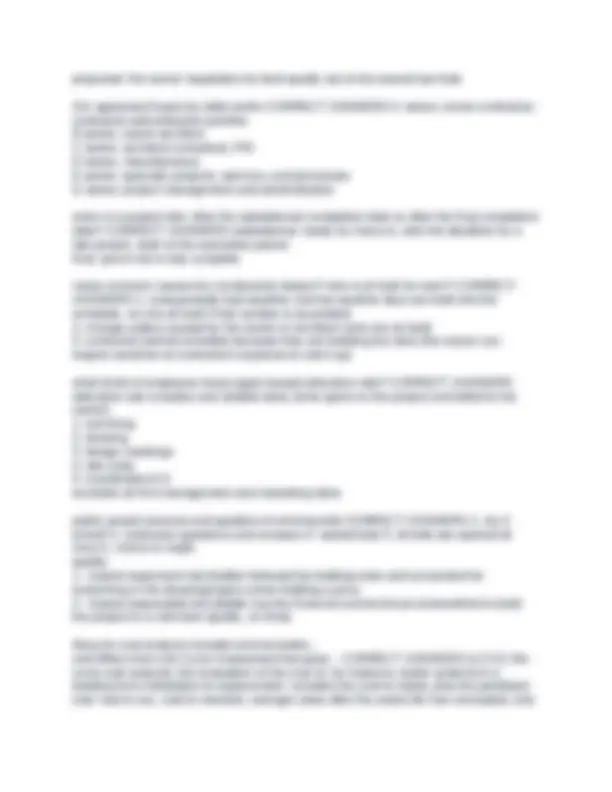


























Study with the several resources on Docsity

Earn points by helping other students or get them with a premium plan


Prepare for your exams
Study with the several resources on Docsity

Earn points to download
Earn points by helping other students or get them with a premium plan
Community
Ask the community for help and clear up your study doubts
Discover the best universities in your country according to Docsity users
Free resources
Download our free guides on studying techniques, anxiety management strategies, and thesis advice from Docsity tutors
Amber Book Practice Management Test Questions And Answers A+ Graded
Typology: Exams
1 / 32

This page cannot be seen from the preview
Don't miss anything!

























What are the levels of a Corporation? CORRECT ANSWERS Stakeholders, Directors, Officers AIA B101 requires which insurances? And for what? CORRECT ANSWERS 1 - General Liability - Covers the physical office space 2 - Professional Liability - Covers errors and omissions 3 - Workers' Compensation Insurance - Covers employee injuries or illness - medical care and lost wages 4 - Automobile Liability - Covers company vehicles and personal cars used for business purposes 5 - Employers' Liability - Covers employers if they get sued for causing a workplace injury (works together with workers' compensation) - settlements, court costs, legal fees Standard of Care CORRECT ANSWERS Expected quality of service for architect by area. The standard of care often decides whether architect is at fault when Architect made an error or omission. Format types for specifications CORRECT ANSWERS Masterformat: classifies by material: concrete, masonry, metals, etc. (older format, more commonly used). Uniformat: classifies by system: substructure, shell interiors, etc. (newer format, better for BIM) Employment Practice Liability Insurance: Intellectual Property Insurance: CORRECT ANSWERS Employment Practice Liability Insurance: Insurance to protect from wrongful termination Intellectual Property Insurance: Insurance to cover claims based on copyright/ intellectual property infringement The owner is responsible for... CORRECT ANSWERS 1. Pre-existing site conditions (geological, hazardous materials, surveying)
Claim - you think you experienced a covered event and demand payment from the insurance company Tail insurance CORRECT ANSWERS Covers the architect's projects after the architect's retirement. The insurance is liability insurance for the projects the architect has already done prior to retirement which are still within the relevant statutes of limitations/repose - so that should there be a problem resulting in a lawsuit, the retired architect is still covered. Tail insurance is much cheaper than the insurance carried by a professional, practicing architect, because the risks are more defined and limited for the insurer - since the architect has retired, no new projects will be built, and all of the projects that need to be covered by the tail insurance are know. What is the process to file an ethical complaint against an architect? CORRECT ANSWERS 1. File the complaint through AIA National
post-occupancy evaluation CORRECT ANSWERS post-occupancy evaluation: surveys used to see how well a building is performing, usually administered at least a year after occupancy contractual liability insurance CORRECT ANSWERS contractual liability insurance: covers you when something goes wrong and you, by virtue of contract you signed, are held responsible for it. Contractual liability coverage typically is included in your general liability insurance (the one that covers your business for non-professional incidents) subrogation CORRECT ANSWERS subrogation: process of the insurance company assuming agency for an insured party in order to sue another party. BUT the AIA A requires a WAIVER of subrogation by all the relevant parties. meaning by contract, the insurance company must still pay the insured, but may not go after the others in the group to recover what the insurance company paid out.
how do you decide how much to charge a client? CORRECT ANSWERS 1. value pricing - based on quality
bank the day after tomorrow, than to make that hiring decision based on the $1,000 you have in the bank today. Cash basis is what you will use to calculate your taxes. If today is December 31, you pay taxes on the profit that you made this calendar year... that $100,000 that will be deposited tomorrow from your client and the $10,000 you'll pay the day after to your engineer: those go into figuring out next year's tax liabilities and don't show up on this year's "cash basis" books. net revenue per employee CORRECT ANSWERS if we charged our clients $300, this year and we had three total employees, our net revenue per employee would be $100,000 (a good goal for a healthy firm). the higher this number is, the healthier the firm is because a high number means that it is bringing in a lot fo money from clients but has few employees to pay. aged accounts receivable CORRECT ANSWERS how many days, on average, between when our firm sends a bill to its client and when we receive the payment from that same client. if its more than 90 days, you're waiting too long surety bond, bid bond, and performance bond CORRECT ANSWERS 1. surety bond: a type of insurance policy that the owner requires the contractor to purchase to be eligible to bid for, or work on, the project. it pays the owner to compete the project if the contractor walks off the job. surety bonds come in two common flavors, bid bonds and performance bonds.
efficiency: inexpensive, repeatable, routine, lots of junior staff. I suspect most of the work done by these "efficiency" firms will be outsourced abroad per the next decades because if you plan to win projects based on your low fees, it will be difficult to compete with overseas labor cost. strategic alliance CORRECT ANSWERS the temporary sharing of technology, resources, and risk to get and build a project. this uses a teaming agreement to lay out credit, copyrights, non-competition clauses, roles, etc. unlike a joint venture, two companies didn't establish a new, third, company. and unlike a partnership, the two companies haven't merged into a single company. they went into the strategic alliance as two companies and came out of it as two companies. overlay district vs. planned use development CORRECT ANSWERS Overlay district: additional zoning requirements for a defined area of town, regardless of the underlying base zoning classification. For instance, for fear of mudslides, the buildings along a bluff, whether zoned for residential, commercial, or industrial, are required to obtain a geotechnical soil report before permission to build is granted. Overlay districts might utilize additional zoning rules to establish historic districts in older parts of the city, protect wildlife in eco-corridors, or promote density along a light rail transit line. Planned use development (PUD): Change in the zoning/code for a specific plot in exchange for other good building practices or public amenities (the city council must approve the PUD). This often grants the developer more zoning flexibility in large-scale, mixed-use land development. For example, a developer interested in purchasing 175 acres currently zoned only for single-family detached homes hires your firm to design a walkable neighborhood replete with shops, schools, street trees, parks, and sidewalks. You then present the proposal to city council to allow the shops in what is currently residential-only zoning. If approved, the municipal government will allow the shops in exchange for the street trees, parks, and sidewalks. They sign off on your plan and will draw up a contract ensuring that you abide by the spirit of it, in exchange for the new zoning flexibility. what rules do you, as an employer, need to follow? name everything you can before you flip the card CORRECT ANSWERS With more employees, your firm is subject to additional regulatory hurdles to protect workers 0-15 employees: FLSA, I-9, HIPAA, ERISA, Equal Pay Act, OSHA, Worker's Compensation, Minimum Wage 16-50: add COBRA, ADEA, ADA, Civil Rights (*20+) 50+ : add FMLA, Obamacare, EEO Reporting, Affirmative Action FSLA = Fair Labor Standards Act. Minimum wage, overtime pay, child labor laws. I-9 = employment eligibility verification. are your employees legally permitted to work in the US? HIPAA= Health Insurance Portability and Accountability Act. Protects privacy of employee health information. You can't tell one employee that another employee is suffering from gout.
ERISA = Employee Retirement Income Security Act. Sets minimum standards for retirement and health plans. For instance, the person who manages the retirement plan must act as a fiduciary (puts the best interest of the plan above their own self-interest) Equal Pay Act = Prohibits wage discrimination by gender OSHA = Occupational Safety and Health Administration. Protects employees from workplace injury. Worker's compensation = gives those injured at work wage replacement and medical treatment COBRA = you lost your job that came with health insurance? you divorced your spouse or your spouse died and you were covered on her health insurance plan? COBRA allows you to temporarily pay out-of-pocket to stay with your old health insurance until you can find a new plan. ADEA = Age Discrimination in Employment Act. Prohibits age discrimination against those 40 and older. you may discriminate against someone for being too young! why? young people don't vote so congress doesn't pass laws to protect them. Civil rights = Civil Rights Act. Protects workers against discrimination on the basis of race, color, religion, gender, and national origin. As of 2020, this also includes Mediation vs. arbitration vs. lawsuit CORRECT ANSWERS Laid out in B101, either: Mediation -> Arbitration (not always cheaper, often ends in 50/50 settlements) -or- Mediation -> Court System (can be cheaper, fairer, and faster, but is also public) owner wants a new architect CORRECT ANSWERS the owner can fire architect without cause (for convenience), though has to pay work-to-date, including overhead and profit. the architect can't transfer the project to another architect because first architect got too busy to finish. each party is responsible for sharing concerns as soon as possible. LLC CORRECT ANSWERS Limited liability company -separates personal assets from company assets; protects personal assets from client lawsuits -small to medium sized company -file with state (for this and any corporation) Filing as an LLC is a good option for a new architecture firm 1.s-corp 2.c-corp 3.b-corp CORRECT ANSWERS 1.s-corporation: small or large company without public stocks - single taxed. personal property protected from client lawsuits. good option for an architecture firm.
about the unit price of each extra room. Unit pricing works best for repetitive elements in a project (street lights, an array of barns for aging whiskey) where the owner wants to buy time before committing (to gather financing for extra landscaping that isn't yet in the budget, to determine if the public's interest in consuming bourbon is permanent or just a passing fad). It also works for elements that are easily quantifiable (earth excavation, linear feet of site-cast concrete retaining wall), also when the owner wants to buy time before committing to an amount of something. Unit pricing does not work well with contractor's "cost of work" includes CORRECT ANSWERS materials, labor, profit, overhead. this is especially important to define up front if the architect's fee is based on a percentage of cost of work. rules for unpaid interns CORRECT ANSWERS 1. similar experience to education
how do you choose whom to staff to a project? CORRECT ANSWERS 1. utilization rate (low rate means they have time to give to the project; high rate means they are already busy with another billable project)
considers how long one system is expected to last as compared to another. boiler A costs less to install but more to operate; boiler B costs more to install but less to operate. LCCA attempts to identify which boiler choice offers a better value, accounting for inflation. useful for a fuller accounting of value beyond simple installation cost comparisons. LCCA explodes sunk costs ( like if two boilers cost the same in design fees and pipe installation, those will not come into play) *not to be confused with Life Cycle Assessment (LCA) which serves as a sustainability tool what is quality management in architecture? CORRECT ANSWERS (QM): intentional and formal process of developing and revising the instruments of service and internal firms systems. For instance, establishing how many cycles of redlining and revising drawings each project will have, or how many times per month the project architect will check in with the client by phone during design. (Also called quality control (QC).
Offering more than one design option Certified designs (LEED, etc) Fast-track BIM coordination Interior design, or furniture, fixtures & equipment (FFE) Post occupancy evaluations Existing facilities survey A/V or security design More than anything, the list above (and more similar items listed in the contract) let the owner know what the architect will not be doing under a standard agreement without compensatory extra fees. That way, when an owner asks later for LEED or a post- occupancy survey, all parties will understand that this is an extra topping on the pizza, and as such, requires an extra fee. Separately, the list below also goes beyond the standard owner-architect contract, so we'll also charge an additional design fee. But this list CANNOT be enumerated or anticipated so a fee may NOT be estimated BEFORE design and are therefore we call these (and charge for these hourly as) ADDITIONAL services. For instance, Amazon initiated same-day delivery to our area, changing the retail market midway through the design process, and the owner asked for a re-design to accommodate smaller retail shopping mall. Or the municipal body that green-lights the project is requiring unforeseen convincing that necessitates slick renderings of the project that weren't part of the contract. Or a new CEO is hired and she wants to see a physical basswood model of the project before construction begins. Or other unforeseen events that require an architect, who has already signed the B101, to put in more effort than reasonably expected relative to the contract. Typically the hourly fee for additional services-whatever the design-bid-build CORRECT ANSWERS owner contracts with the architect to draw, and then the contractor who bids a fixed price based on those drawings. *this project type is linear and clearly defined, with the lowest immediate cost, a longer schedule, and a higher chance of large change orders. due to the change orders risk, the drawings need to be more complete earlier in the process *this was, for a long time, the most common type of contract and serves as the default option assumed in the ARE unless otherwise specified bridged design-build CORRECT ANSWERS owner contracts with a design architect ("bridging consultant") to design the project through SD, then a "reduction architect- contractor team" bids to develop the documents and build the project. this contract retains some fo the adversarial relationship between the architect and contractor because the bridging consultant (design architect) works for the owner and has her best interest in mind; and it retains some fo the speed and expediency associated with design-build projects because the production architect and contractor work for a single entity and ostensibly trust one another without the blame-shifting or cover-your-ass
an architecture Billings index (ABI) of 48 in "inquiries" means CORRECT ANSWERS the financial future outlook for architects ticked down last month by a very small amount. the ABI is a running monthly number: an economic indicator for construction activity. A number more than 50 means the financial outlook improved over last month; a number below 50 means the financial outlook declined relative to last month. there are separate ABI numbers for Billings, new design contracts, and inquiries... for residential, industrial, public, and commercial sectors.. and for the Midwest, northeast, south and west regions of the US. if the owner-architect contract stipulates that the architect's fee will be 7% of construction costs, and the project is abandoned after CDs (and therefore has a construction cost of $0), is the architect entitled to payment? CORRECT ANSWERS the architect is paid, even if the project isn't constructed, because the contract is based on the "owner's budget for the cost of work" not the "cost of work" from the contract: 'the architect shall be entitled to compensation in accordance with this agreement for all services performed whether or not the construction phase is commenced" you own a firm and provide life insurance to your staff as a benefit of employment. is that benefit taxable? CORRECT ANSWERS the premium (monthly cost) of the first $50,000 of life insurance is not-taxable, but after that, the rest is subject to tax. the employee will then pay some tax on large life insurance plans. wages, salaries, and bonuses are considered taxable income. many benefits, like child care nd contributions employees make to health insurance plans may to be subject to taxes. what do yo duo if an exam question asks you which firm employee to assign to a project? CORRECT ANSWERS 1. look for a staff member who has experience in the building program type.
control" over a drawing set (including specs, reports, etc.) if you possess a knowledge of, or maintain supervision over, that set consistent with the standard of care. In other words, you can stamp plans that you didn't create, but you can't stamp plans you know little about. How much do you have to know about the set before you can ethically stamp them? Enough to be consistent with what other architects in your area are doing for similar projects (that's the "standard of care" part). can you, as the architect, stamp the work of consultants? CORRECT ANSWERS you may stamp the work of a licensed consultant, if you have, "reviewed it, coordinated its preparation, or intend to be responsible for its adequacy" AIA Code of Ethics CORRECT ANSWERS review code of ethics. is it unethical for an architect to offer free services? CORRECT ANSWERS it is not unethical for an architect to offer free services. the aia used to be in the business of establishing fees, outlawing discounts, and regulating when an architect could submit a bid to undercut the fee established by another firm. they took this role to protect the profession from a "race to the bottom" whereby architects would undercut one another on price ad infinitum - but those protectionist policies ran afoul of antitrust laws. the federal gov. deemed that practice to be too much like a cartel, and contrary to the free- market tradition of competitive bidding. how many times does an architect need to goof before they are disciplined by the profession? CORRECT ANSWERS there is no hard minimum number of lapses. instead, trouble arises after failing to "demonstrate a consistent pattern of reasonable care and competence" and like so much else in an architects liability portfolio, that bar to clear is established by "standard of care" norms: other architects practicing in the same locality at the same time. can you fire an employee because you don't like the color of their shoelaces? CORRECT ANSWERS yes, you can fire for any reason provided it is not the employee's race, gender, national origin, disability, religion, or genetic information, or sexual orientation. or for age (if over 40). harassment is both illegal and subject to discipline within the profession, and includes offensive slurs, offensive jokes, unwanted physical contact, insults, petty slights, and interference with work performance. can an architect contribute to a campaign of a local politician in the hope of winning a contract to design a new firehouse, should that politician become elected? CORRECT ANSWERS tough call.. but probably okay. architects are prohibited from offering payments or gifts to public officials with the intent of influencing the official's judgement related to a juicy building project. but that rule does not apply when making legal campaign contributions! is an architect who is working with a developer allowed to stand up in a city council meeting and speak in support of the developer's project? CORRECT ANSWERS